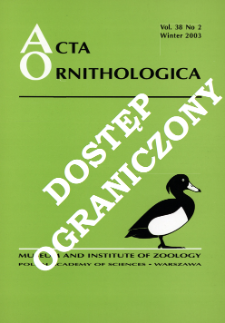
Object
Title: Predicting densities of wintering redshank Tringa totanus from estuary characteristics: a method for assessing the likely impact of habitat change
Creator:
Rehfisch, Marc Mansel ; Austin, Graham E. ; Clark, Nigel A. ; Clarke, Ralph T. ; Holloway, Steve J. ; Yates, Mick G. ; Dit Durell, Sarah E. A. le V. ; Eastwood, Jim A. ; Goss-Custard, John D. ; Swetnam, Ruth D. ; West, John R.
Date issued/created:
Resource type:
Subtitle:
Acta Ornithologica, vol. 35, no. 1 ; Prognozowanie zagęszczeń zimujących brodźców krwawodziobych w oparciu o charakterystykę estuariów - szkicowanie oddziaływania zmian środowiskowych ; Densities of wintering redshank and estuary characteristics
Contributor:
Polska Akademia Nauk. Muzeum i Instytut Zoologii ; Meeting of the European Ornithologists' Union (2 ; 1999 ; Gdańsk)
Publisher:
Muzeum i Instytut Zoologii PAN
Place of publishing:
Description:
Referat wygłoszony na Second Meeting of the European Ornithologists' Union ; Bibliogr. s. 31-32 ; S. [25]-32 : il. ; 27 cm ; Streszcz. pol. Nazwy taksonów także w jęz. łac.
Type of object:
Abstract:
The UK's estuaries are internationally important for wintering waterfowl and yet these habitats are subject to a range of pressures. For example, some 88% of them have been affected by landclaim. This stress to estuaries will be compounded by global climate change, which will lead to sea level rise. It would be valuable, therefore, to be able to predict the likely impact of such pressures on waterfowl using estuaries. This paper presents a method, based on environmental variables that can easily be collected, which allows the effect of habitat change on densities of wintering waterfowl to be predicted for individual estuaries. The application of the methodology is demonstrated in detail for Redshank. Waterfowl counts were carried out two hours either side of low tide over two winters at 27 estuarine sites in Britain. The sediment classification was obtained from the interpretation of airborne or satellite thematic imagery. The morphology of each site was measured largely from maps. A combination of estuary length, estuary width, tidal range and longitude describe 87% of the variance in the whole estuary Redshank densities. A model based on sediment, the proportion of mud in estuaries, explained 48% of the variance. The suspected reasons behind the higher predictive potential of the former model are discussed. Two examples of the use of these models in predicting the likely effects of human developments on waterfowl populations are demonstrated. Further development of the models is suggested which would allow them to be applied to an important conservation issue, global climate change.
Relation:
Volume:
Issue:
Start page:
End page:
Detailed Resource Type:
Artykuł ; Materiały konferencyjne
Format:
Resource Identifier:
Source:
MiIZ PAN, patrz sygn. czas. P.257, Vol. 35, No 1 ; MiIZ PAN, patrz sygn. czas. P.4568, Vol. 35, No 1 ; click here to follow the link
Language:
Rights:
Prawa zastrzeżone - dostęp ograniczony
Terms of use:
Digitizing institution:
Muzeum i Instytut Zoologii Polskiej Akademii Nauk
Original in:
Biblioteka Muzeum i Instytutu Zoologii PAN
Projects co-financed by:
Program Operacyjny Innowacyjna Gospodarka, lata 2010-2014, Priorytet 2. Infrastruktura strefy B + R ; Unia Europejska. Europejski Fundusz Rozwoju Regionalnego
Access:
Object collections:
- Digital Repository of Scientific Institutes > Partners' collections > Museum and Institute of Zoology PAS > Scientific Journals
- Digital Repository of Scientific Institutes > Partners' collections > Museum and Institute of Zoology PAS > MIZ PAN Publications > Acta Ornithologica
- Digital Repository of Scientific Institutes > Literature > Journals/Articles
Last modified:
Oct 2, 2020
In our library since:
May 22, 2014
Number of object content downloads / hits:
106
All available object's versions:
https://www.rcin.org.pl/publication/61258
Show description in RDF format:
Show description in RDFa format:
Show description in OAI-PMH format:
Objects Similar
Gallo-Orsi, Umberto Boere, Gerard
Gromadzka, Jadwiga
Zając, Ryszard Zygmunt (1936– )
Piersma, Theunis Dietz, Maurine W. Dekinga, Anne Nebel, Silke Gils, Jan van Battley, Phil F. Spaans, Bernard
Król, Elżbieta
Józefik, Mieczysław (1930– ) Swirski, Zbigniew (1926– )
Jenni, Lukas

 INSTYTUT ARCHEOLOGII I ETNOLOGII POLSKIEJ AKADEMII NAUK
INSTYTUT ARCHEOLOGII I ETNOLOGII POLSKIEJ AKADEMII NAUK
 INSTYTUT BADAŃ LITERACKICH POLSKIEJ AKADEMII NAUK
INSTYTUT BADAŃ LITERACKICH POLSKIEJ AKADEMII NAUK
 INSTYTUT BADAWCZY LEŚNICTWA
INSTYTUT BADAWCZY LEŚNICTWA
 INSTYTUT BIOLOGII DOŚWIADCZALNEJ IM. MARCELEGO NENCKIEGO POLSKIEJ AKADEMII NAUK
INSTYTUT BIOLOGII DOŚWIADCZALNEJ IM. MARCELEGO NENCKIEGO POLSKIEJ AKADEMII NAUK
 INSTYTUT BIOLOGII SSAKÓW POLSKIEJ AKADEMII NAUK
INSTYTUT BIOLOGII SSAKÓW POLSKIEJ AKADEMII NAUK
 INSTYTUT CHEMII FIZYCZNEJ PAN
INSTYTUT CHEMII FIZYCZNEJ PAN
 INSTYTUT CHEMII ORGANICZNEJ PAN
INSTYTUT CHEMII ORGANICZNEJ PAN
 INSTYTUT FILOZOFII I SOCJOLOGII PAN
INSTYTUT FILOZOFII I SOCJOLOGII PAN
 INSTYTUT GEOGRAFII I PRZESTRZENNEGO ZAGOSPODAROWANIA PAN
INSTYTUT GEOGRAFII I PRZESTRZENNEGO ZAGOSPODAROWANIA PAN
 INSTYTUT HISTORII im. TADEUSZA MANTEUFFLA POLSKIEJ AKADEMII NAUK
INSTYTUT HISTORII im. TADEUSZA MANTEUFFLA POLSKIEJ AKADEMII NAUK
 INSTYTUT JĘZYKA POLSKIEGO POLSKIEJ AKADEMII NAUK
INSTYTUT JĘZYKA POLSKIEGO POLSKIEJ AKADEMII NAUK
 INSTYTUT MATEMATYCZNY PAN
INSTYTUT MATEMATYCZNY PAN
 INSTYTUT MEDYCYNY DOŚWIADCZALNEJ I KLINICZNEJ IM.MIROSŁAWA MOSSAKOWSKIEGO POLSKIEJ AKADEMII NAUK
INSTYTUT MEDYCYNY DOŚWIADCZALNEJ I KLINICZNEJ IM.MIROSŁAWA MOSSAKOWSKIEGO POLSKIEJ AKADEMII NAUK
 INSTYTUT PODSTAWOWYCH PROBLEMÓW TECHNIKI PAN
INSTYTUT PODSTAWOWYCH PROBLEMÓW TECHNIKI PAN
 INSTYTUT SLAWISTYKI PAN
INSTYTUT SLAWISTYKI PAN
 SIEĆ BADAWCZA ŁUKASIEWICZ - INSTYTUT TECHNOLOGII MATERIAŁÓW ELEKTRONICZNYCH
SIEĆ BADAWCZA ŁUKASIEWICZ - INSTYTUT TECHNOLOGII MATERIAŁÓW ELEKTRONICZNYCH
 MUZEUM I INSTYTUT ZOOLOGII POLSKIEJ AKADEMII NAUK
MUZEUM I INSTYTUT ZOOLOGII POLSKIEJ AKADEMII NAUK
 INSTYTUT BADAŃ SYSTEMOWYCH PAN
INSTYTUT BADAŃ SYSTEMOWYCH PAN
 INSTYTUT BOTANIKI IM. WŁADYSŁAWA SZAFERA POLSKIEJ AKADEMII NAUK
INSTYTUT BOTANIKI IM. WŁADYSŁAWA SZAFERA POLSKIEJ AKADEMII NAUK


































